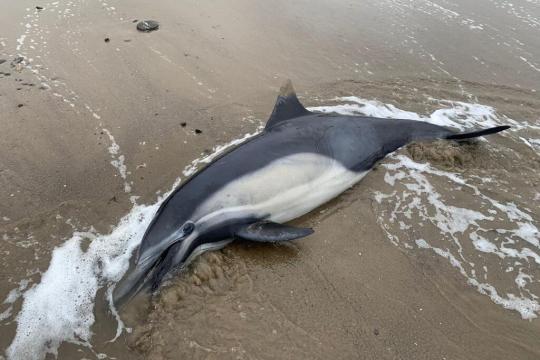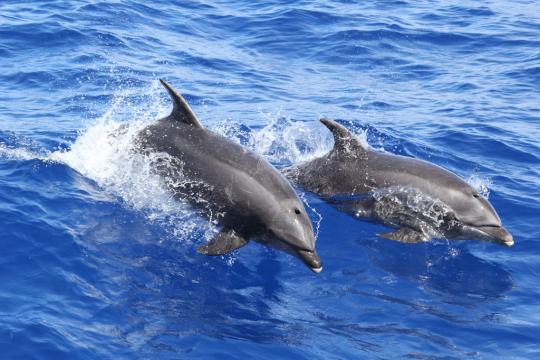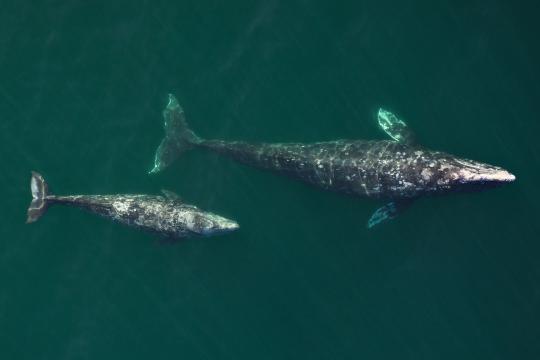Pacific White-Sided Dolphin
Lagenorhynchus obliquidens

Protected Status
Quick Facts
 Pacific White-Sided Dolphin. Credit: NOAA Fisheries
Pacific White-Sided Dolphin. Credit: NOAA Fisheries
Pacific White-Sided Dolphin. Credit: NOAA Fisheries
About the Species
 Pacific White-Sided Dolphin. Credit: NOAA Fisheries
Pacific White-Sided Dolphin. Credit: NOAA Fisheries
Pacific White-Sided Dolphin. Credit: NOAA Fisheries
Pacific white-sided dolphins, known for the distinct coloring that give them their name, are a playful and highly social marine mammal. They are also sometimes known as the “hookfin porpoise” because of their large, curved dorsal fin, though they are not technically porpoises.
In the United States, Pacific white-sided dolphins live off the coasts of California, Oregon, Washington, and Alaska. They can be seen traveling in schools of thousands, but group sizes are usually between 10 and 100 animals. These extremely playful dolphins are often seen “bow riding” (swimming near the front part of a ship) and jumping, somersaulting, or even spinning in the air.
Pacific white-sided dolphins in the United States are not endangered or threatened, but they are protected under the Marine Mammal Protection Act. A primary threat to Pacific white-sided dolphins is entanglement in fishing gear, such as gillnets and trawls.
NOAA Fisheries is dedicated to the conservation and protection of Pacific white-sided dolphins. We are working to help conserve this species through collaborative management, integrated science, partnerships, and outreach.
Population Status
NOAA Fisheries estimates the population size for Pacific white-sided dolphins in its stock assessment reports. In all, there are three stocks of Pacific white-sided dolphins in U.S. waters. Population trends for the North Pacific stock off the coast of Alaska are unknown. A survey of the two stocks off the coasts of Washington, Oregon, and California from 2008 to 2014 found a population of more than 21,000 dolphins.
Appearance
These dolphins have a robust body, short rostrum (snout), and large dorsal fin compared to their overall body size. Their back, flukes (tail), and lips are black; their sides, dorsal fin, and flippers are gray; and their belly is white. They have a white or light gray stripe along their sides that extends from their eye to their tail, sometimes referred to as "suspenders." Pacific white-sided dolphins are most likely to be confused with common dolphins and Dall’s porpoises because they have similar large light-colored flank patches.
The average adult Pacific white-sided dolphin weighs about 300 to 400 pounds and is between 5.5 and 8 feet long, with males being generally larger than females.
Behavior and Diet
Pacific white-sided dolphins feed on a variety of prey, such as squid and small schooling fish (capelin, sardines, and herring). They can dive underwater for more than 6 minutes to feed. They have small conical teeth that help them catch and hold on to their prey; each tooth row contains 23 to 36 pairs of teeth. Instead of using their teeth to chew their food, dolphins use their teeth to grip food before swallowing it whole—head first—so the spines of the fish do not catch in their throats. Pacific white-sided dolphins often work together as a group to herd schools of fish. Each adult eats about 20 pounds of food a day.
Where They Live
Pacific white-sided dolphins are pelagic, meaning they live in the open ocean and nearshore waters, but are unlikely to be found close to shore. They live in the temperate waters of the North Pacific Ocean. In the United States, they are found off the coast of California, Oregon, Washington, and Alaska. Worldwide, they are found in the southern Bering Sea (around the Aleutian Islands), Sea of Okhotsk, Sea of Japan, and Yellow and East China Seas to the south of Japan.
 World map providing approximate representation of the Pacific white-sided dolphin's range.
World map providing approximate representation of the Pacific white-sided dolphin's range.
Lifespan & Reproduction
The Pacific white-sided dolphin can live more than 40 years. Males reach sexual maturity around 10 years and females around 8 to 11. They mate and give birth from late spring to fall, except in the central Pacific, where calves are born in late winter to spring. Gestation is usually 9 to 12 months, and calves weigh about 30 pounds at birth and are about 3 to 4 feet. Mothers nurse their calves for up to 18 months and females usually give birth every 3 years.
Threats
Interactions with Fishing Gear
One of the main threats to the Pacific white-sided dolphin is entanglement in fishing gear. Dolphins can become entangled or captured in commercial fishing gear such as gillnets, seines, trawls, trap pots, and longlines.
Before a 1933 United Nations moratorium that banned large-scale drift nets, Pacific white-sided dolphins were often captured by Japanese fisheries. In addition, every year between 1978 and 1991, thousands of Pacific white-sided dolphins suffered mortality and serious injury when caught incidentally in high-seas fisheries for salmon and squid. These fisheries were closed in 1991 and no other large-scale fisheries have operated in the central North Pacific since 1991.
Ocean Noise
Low-frequency underwater noise pollution can interrupt the normal behavior of Pacific white-sided dolphins. Noise interference hinders their ability to use sound, which in turn disturbs their ability to communicate, choose mates, find food, avoid predators, and navigate.
Scientific Classification
| Kingdom | Animalia | Phylum | Chordata | Class | Mammalia | Order | Cetacea | Family | Delphinidae | Genus | Lagenorhynchus | Species | obliquidens |
|---|
Last updated by NOAA Fisheries on 09/16/2022
What We Do
Conservation & Management
All Pacific white-sided dolphins are protected under the MMPA. Our work supports the protection and conservation of Pacific white-sided dolphins by:
- Reducing interactions with commercial fishing gear
- Minimizing the effects of vessel disturbance, noise, and other types of human impacts
- Responding to dead, injured, or entangled dolphins
Science
NOAA Fisheries conducts research on the biology, behavior, and ecology of Pacific white-sided dolphins to better inform management and policy. Examples include:
- Undertaking stock assessments to determine the status of populations and/or sub-populations
- Examining population structure, abundance, and dynamics using a variety of research techniques, including photo-identification and genetics
- Investigating causes of mortality (especially in unusual cases)
- Conducting ecosystem and habitat monitoring
How You Can Help
Don't Feed Wild Dolphins
Dolphins fed by humans lose their natural wariness and learn to associate people with food, causing them to beg for handouts and take bait and catch directly from fishing gear. This puts them at risk from vessel strikes and becoming entangled in or ingesting fishing gear. Dolphins may teach these behaviors to their young, thereby putting them at risk.
More on protecting wild dolphins and admiring them from a distance
Keep Your Distance
Be responsible when viewing marine life in the wild. Observe all dolphins and porpoises from a safe distance of at least 50 yards and limit your time spent observing to 30 minutes or less.
Report Marine Life in Distress
Report a sick, injured, entangled, stranded, or dead animal to make sure professional responders and scientists know about it and can take appropriate action. Numerous organizations around the country are trained and ready to respond. Never approach or try to save an injured or entangled animal yourself—it can be dangerous to both the animal and you.
Learn who you should contact when you encounter a stranded or injured marine animal
Report a Violation
Call the NOAA Fisheries Enforcement Hotline at (800) 853-1964 to report a federal marine resource violation. This hotline is available 24 hours a day, 7 days a week for anyone in the United States.
You may also contact your closest NOAA Office of Law Enforcement field office during regular business hours.
Featured News
 Deceased dolphin as a result of domoic acid poisoning. Credit: Channel Islands Marine & Wildlife Institute
Deceased dolphin as a result of domoic acid poisoning. Credit: Channel Islands Marine & Wildlife Institute
 Pair of bottlenose dolphins. Credit: NOAA Pacific Islands Fisheries Science Center/Lisa Morse.
Pair of bottlenose dolphins. Credit: NOAA Pacific Islands Fisheries Science Center/Lisa Morse.
 Gray whales were nearly hunted to extinction by commercial whaling. Protections under the MMPA, ESA, and the end of commercial whaling have allowed the species to recover. Credit: NOAA Fisheries (Permit #19091).
Gray whales were nearly hunted to extinction by commercial whaling. Protections under the MMPA, ESA, and the end of commercial whaling have allowed the species to recover. Credit: NOAA Fisheries (Permit #19091).
 Finback whales. Credit: NOAA Fisheries
Finback whales. Credit: NOAA Fisheries
Management Overview
Pacific white-sided dolphins are protected under the Marine Mammal Protection Act. They are not considered endangered or threatened under the Endangered Species Act. NOAA Fisheries and our partners work to conserve and protect this species in many ways.

Conservation Efforts
Dolphin-Safe/Tuna Tracking and Verification Program
Dolphins, like other marine mammals, may become bycatch in fisheries. Some species of tuna are known to aggregate beneath schools of certain dolphin stocks. In some parts of the world, this close association led to the fishing practice of encircling a dolphin school to capture the tuna concentrated below. The Dolphin Protection Consumer Information Act established a national tuna tracking program to ensure that tuna imported into the United States meets certain requirements to ensure the safety of dolphins during tuna fishing operations.
Learn more about the Dolphin-Safe/Tuna Tracking and Verification Program
Reducing Interactions with Fishing Gear
Bycatch in fishing gear is a leading cause of Pacific white-sided dolphin deaths and injuries. To reduce deaths and serious injuries from drift gillnet commercial fishing gear off the coast of California and Oregon, NOAA Fisheries implemented the Pacific Offshore Cetacean Take Reduction Plan in 1997. Representatives from NOAA, the fishing industry, regional fishery management councils, state and federal resource management agencies, the scientific community, and conservation organizations worked together to develop the plan. The plan included skipper education workshops and required the use of pingers and minimum 6-fathom extenders to provide a net-free zone at surface waters for safe passage by dolphins. As a result, overall entanglement rates in the drift gillnet fishery dropped considerably.
Learn more about bycatch and fisheries interactions
Minimizing Harassment and Illegal Feeding
As human interactions with wild dolphins increase, so does the risk of disturbing or injuring these animals. NOAA Fisheries provides guidance on how to safely and responsibly view dolphins, including the following initiatives:
Learn more about the rules regarding feeding and harassing marine mammals in the wild
Addressing Ocean Noise
Underwater noise threatens marine mammal populations, interrupting their normal behavior and driving them away from areas important to their survival. Increasing evidence suggests that exposure to intense underwater sound in some settings may cause some cetaceans to strand and ultimately die. NOAA Fisheries researches aspects of acoustic communication and hearing in marine animals, as well as the effects of sound on marine mammal behavior and hearing. In 2018, we revised technical guidance for assessing the effects of anthropogenic (human-caused) sound on marine mammal hearing.
Overseeing Marine Mammal Health and Stranding Response
We work with volunteer networks in all coastal states to respond to marine mammal strandings including all dolphins and porpoises. When stranded animals are found alive, NOAA Fisheries and our partners assess the animal’s health and determine the best course of action. When stranded animals are found dead, our scientists work to understand and investigate the cause of death. Although the cause often remains unknown, scientists can sometimes attribute strandings to disease, harmful algal blooms, vessel strikes, fishing gear entanglements, pollution exposure, and underwater noise. Some strandings can serve as indicators of ocean health, giving insight into larger environmental issues that may also have implications for human health and welfare.
Learn more about the Marine Mammal Health and Stranding Response Program
Marine Mammal Unusual Mortality Events
Pacific white-sided dolphins have never been part of a declared unusual mortality event. Under the Marine Mammal Protection Act, an unusual mortality event is defined as "a stranding that is unexpected; involves a significant die-off of any marine mammal population; and demands immediate response." To understand the health of marine mammal populations, scientists study unusual mortality events.
Get information on active and past UMEs
Get an overview of marine mammal UMEs

Regulatory History
All Pacific white-sided dolphins are protected under the MMPA.
Before the United Nations issued a moratorium that banned large-scale drift nets in 1933, Japanese fisheries often captured Pacific white-sided dolphins. The MMPA was later enacted in 1972 to protect all marine mammals, severely reducing the amount of animals injured and/or killed. This species is now no longer commercially hunted in the United States, though some Pacific white-sided dolphins are still harvested for food in Japan's coastal fisheries.
In 1999, the United States signed on as a Party to the Agreement on the International Dolphin Conservation Program. In addition to other requirements, the AIDCP's main objective is to reduce incidental dolphin mortalities in the tuna purse-seine fishery.
The International Dolphin Conservation Program Act (PDF, 19 pages) amended the MMPA to make AIDCP objectives and requirements legally effective in the United States.
Key Actions and Documents
Last updated by NOAA Fisheries on 09/16/2022
Science Overview
NOAA Fisheries conducts research on the biology, behavior, and ecology of the Pacific white-sided dolphin. The results of this research are used to inform management decisions and conservation efforts for this species and other marine life.

Stock Assessments
Determining the size of Pacific white-sided dolphin populations helps resource managers determine the success of our conservation measures. NOAA Fisheries scientists collect population information from various sources and present the data in an annual stock assessment report.
Aerial and Shipboard Surveys
Scientists use small aircraft and research vessels to spot Pacific white-sided dolphins and photograph them to identify individuals and record their seasonal distribution. Understanding this species’ distribution patterns helps managers establish measures to limit the overlap between fisheries and dolphins. This research can be used to inform management actions that protect the Pacific white-sided dolphin. A review of sighting reports and bycatch data from the Bering Sea suggests Pacific white-sided dolphin presence is not rare, occurs year-round, extends farther north than shown on current range maps, and that site-fidelity may occur in areas near and within Bristol Bay.
Research Projects
NOAA Fisheries scientists conduct guided research projects to answer questions about a particular ecosystem or ecology. For example, the Cetacean Assessment and Ecology Program conducts studies to assess the status of cetaceans in Alaskan waters under the Endangered Species Act and the Marine Mammal Protection Act, which includes the Pacific white-sided dolphin. The program uses the results of stock assessments, surveys, and studies to provide the scientific advice necessary to manage cetaceans in Alaskan waters.
Acoustic Science
Other research focuses on the acoustic environment of cetaceans, including the Pacific white-sided dolphin. Acoustics is the science of how sound is transmitted. This research involves increasing our understanding of the basic acoustic behavior of whales, dolphins, and fish; mapping the acoustic environment; and developing better methods to locate cetaceans using autonomous gliders and passive acoustic arrays.
More Information
Last updated by NOAA Fisheries on 09/16/2022
Outreach & Education
Dolphin Friendly Fishing Tips Sign
This sign is often posted near boat ramps, piers, docks, marinas, and waterfront parks.
Protect Wild Dolphins Sign
This sign is often posted near boat ramps, piers, docks, marinas, and waterfront parks.
Don't Feed Wild Dolphin Sign
This sign is often posted near boat ramps, piers, docks, marinas, and waterfront parks.
Last updated by NOAA Fisheries on 09/16/2022



